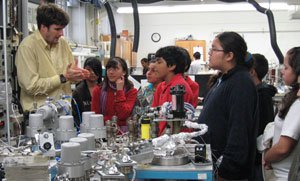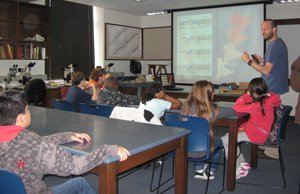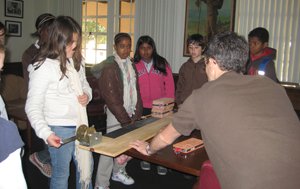Sixty sixth graders from Hamilton Elementary School in Pasadena recently visited campus to tour Caltech's Tectonics Observatory and Seismological Laboratory. Their first stop was the lab of grad student Willy Amidon (right), who showed them his collection of geologic specimens and asked, "How old are these rocks?" He then showed them how to answer that question by demonstrating the methods scientists use in the cosmogenic dating of rocks, from grinding the samples to extracting microscopic zirconium crystals and then baking them in a mass spectrometer to drive off and measure helium-3.
Amidon explained that when the sun's cosmic rays hit a rock, He-3 is produced and then trapped in zirconium crystals. The He-3 only starts to build up when the rock reaches Earth's surface and is exposed to the rays—so the more He-3 present, the longer the rock has been at the surface, and the older it is.
The sixth graders next visited Caltech postdoc Itai Haviv (right), who gave a presentation on the rise of the Himalayas. He explained how the world's highest mountain range was born and how scientists conduct geologic field work in remote areas with no roads. He also showed how scientists separate the rate of mountain building from the rate of erosion by examining the different minerals in Himalayan rocks to estimate the age of the rocks, and hence the mountains' growth rate.
The students' final stop was with Tectonics Observatory research seismologist Anthony Sladen (below), who discussed the two recent earthquakes in Chile and Haiti. He showed them how to use Google Earth to locate the fault responsible for the Haitian quake, and how to find the epicenters of the two earthquakes and the locations of their numerous aftershocks. Sladen explained that the images of Haiti on Google Earth are so detailed that rescue teams were able to use the application to locate people after the disaster.
The students also created their own earthquakes using "earthquake machines" built with blocks, sandpaper, and springs. The resulting seismic waves were then detected and displayed on a laptop using the Mac OS X application SeisMac. Through this simple model, they learned firsthand why it is not possible for seismologists to predict the next earthquake.






